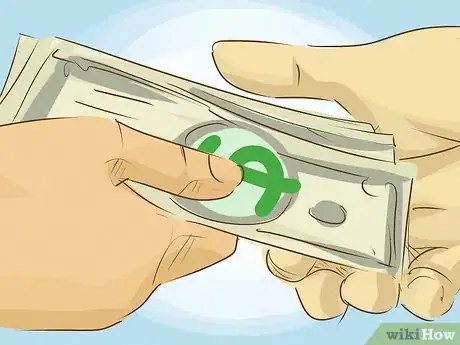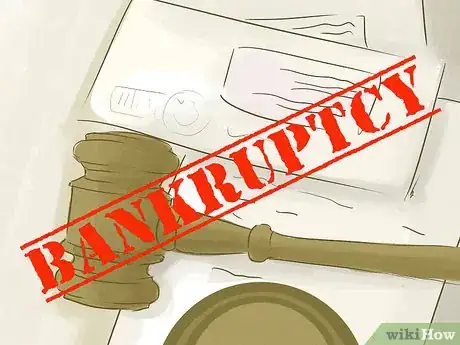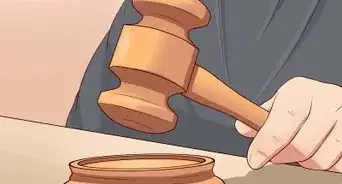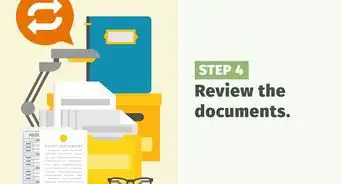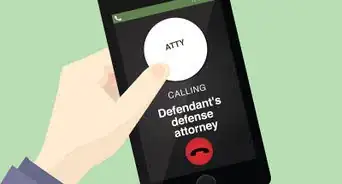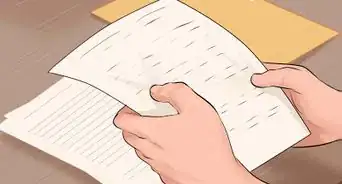This article was co-authored by Clinton M. Sandvick, JD, PhD. Clinton M. Sandvick worked as a civil litigator in California for over 7 years. He received his JD from the University of Wisconsin-Madison in 1998 and his PhD in American History from the University of Oregon in 2013.
There are 7 references cited in this article, which can be found at the bottom of the page.
This article has been viewed 54,838 times.
When a lawsuit concludes, one party (the debtor) is usually ordered to pay money to the other party (the creditor). Enforcing the judgment can be frustrating and difficult for both parties, especially if the process drags on for a long time. Both parties can make the process easier by agreeing to settle the debt. If you do not settle the judgment or pay it in full, then the creditor may take further action, such as garnishing wages, levying bank accounts, or getting a lien on the debtor's property.[1]
Steps
Negotiating the Debt Amount
-
1Read the judgment. Debtors and creditors should review the court order (judgment) to determine the total amount due and any specific payment instructions ordered by the court. If you do not believe the order accurately reflects the ruling the court made, then contact an attorney quickly for assistance in correcting the order.
-
2Evaluate your financial situation. Whether you are the creditor or the debtor, you should review your finances before negotiating the amount of the debt. If you are the creditor and need money right away, you might be more willing to accept a smaller amount to settle the debt quickly instead of accepting the full amount over time via monthly payments. If you are the debtor, you need to determine whether you can pay the full amount of the judgment up front, or whether you need to try to negotiate away some of the debt and/or make a payment plan.
- Creditors can use alternative methods to collect the judgment or put pressure on the debtor, such as garnishing wages, freezing bank accounts, securing a lien against a home, and trying to force a sale.[2] Exercising these options takes time and money, as the creditor typically must return to court to get a court order.
- Debtors can make it more difficult for creditors to reach their assets. For instance, if you suspect your creditor is trying to levy your bank account, you can move your money to a new account. Also, some judgment debts can be discharged in bankruptcy. Creditors will often accept less than the full amount of the debt if they suspect that the debtor will file bankruptcy to avoid the debt entirely.
Advertisement -
3Contact the other party. If you have an attorney, let him or her handle the negotiations. If you are representing yourself, contact the other party, or his or her attorney. Let them know that you are interested in settling the judgment, and make an offer of payment (if you are the debtor) or a demand (if you are the creditor).
- If you come to an agreement, or if the other side makes an offer, it is a good idea to get a confirmation in writing. You can write an letter or an email after a phone call, saying, for example, "This is to confirm our discussion earlier today, during which you offered to settle the judgment for $500. I said I would consider your offer and accept or reject by Tuesday, June 1."
-
4Start with a favorable offer. Creditors should demand the full amount of the debt, while debtors will want to start with a (reasonable) lowball offer. Expect to compromise and meet closer to the middle. When making an offer, consider the amount and the length of the payment plan.
- Creditors may want to factor in the cost of having to go back to court to seize a debtor's assets. For instance, if it will cost you $200 in fees and costs to levy the debtor's bank account, so you might want to consider settling for $200 less than the full amount of the debt.
- Debtors should be prepared to share their hardship circumstances during negotiations. Consider this hypothetical case: A debtor owes a $1000 judgment, but he cannot afford to pay it because he was unemployed for three months and almost depleted his savings before he found a new job. The debtor offers to pay 20% of the debt ($200) in two monthly installments. The creditor agrees to accept this greatly reduced payment because the creditor understands that he is not likely to get much more from the debtor, and because he will get nothing if the debtor decides to file for bankruptcy.
Establishing a Payment Plan
-
1Put your settlement in writing. At a minimum, the debtor should type up the terms of the settlement in a letter and send it to the creditor along with the first payment. That letter should include the phrase, "Acceptance of this payment constitutes your agreement with the terms documented in this letter." A better option is to write a settlement agreement and make sure both parties sign it and get copies. Include the following terms in your settlement agreement:
- The names of the parties;
- The case number;
- The payment terms, including:
- The total settlement amount
- The amount of each payment
- The due date of each payment (monthly, etc.)
- The form of payment (check, cash, credit card, etc.);
- A statement that the creditor will not enforce the judgment as long as the debtor makes the specified payments; and
- A statement that the creditor will file a "satisfaction of judgment" with the court once the last payment is made.
-
2Follow the agreement precisely. The debtor should follow the terms of the repayment exactly as drafted, and send the amount agreed upon on the agreed date. You might consider setting up automatic payments with your bank or credit union to make sure that you don't forget to make a payment.
- If you are the creditor, keep track of the payments being made and ensure you are getting the money you are owed. In addition, do not you, as the creditor, need to make sure you are not breaking any terms of the agreement. For example, if you have promised not to enforce the judgment so long as payments are coming in, do not go to court and garnish the debtor's wages if they are paying you.
-
3Contact the other party if there is a problem with repayment. If you are the debtor and are about to miss a payment or need to modify the repayment schedule, contact the creditor. Explain the situation and propose a solution. The creditor does not have to agree, but if you can compromise again, you can renegotiate the settlement and avoid having to go to court.
-
4File a Satisfaction of Judgment form after the final payment has been made. Each court has a form, usually called a Satisfaction of Judgment, that the parties use to verify that the judgment has been paid. It is usually the creditor's responsibility to file the form. For example, in California, the creditor must file within 15 days of receiving the last payment, or else the debtor can sue the creditor for $50.[3] The judge will review the form and sign it. Make sure that both parties get signed copies.
-
5Update your credit report. Get three certified copies of the Satisfaction of Judgment from the court clerk (you may have to pay a fee). Mail a copy to each of the three credit reporting agencies: Equifax, Experian, and TransUnion.[4] Your credit report will show that the judgment is "satisfied." The judgment will still remain on your report for seven years from the date the judgment was entered.
Taking Further Action
-
1Consider filing for bankruptcy. With a Chapter 7 bankruptcy, a debtor can discharge most debts. However, judgment debts relating to fraud, intentional injury, and DUI-related injury or wrongful death cannot be discharged.[5] Contact a bankruptcy attorney to discuss your options.
- If you are considering filing for bankruptcy, you may want to have a bankruptcy attorney speak with your creditor. If the creditor sees that you are seriously contemplating bankruptcy, he or she may be willing to settle the judgment for much less than the total amount, rather than risk getting nothing. In turn, if the debtor can settle the judgment, bankruptcy may not be necessary.
-
2Garnish the debtor's wages. If the parties cannot settle the debt, the creditor can garnish the debtor's wages. The creditor must file a Writ of Execution with the court. Blank forms are usually available online. Once signed by the judge, the writ authorizes the county sheriff to instruct the debtor's employer to withhold a portion of the debtor's wages. Unless the debtor successfully challenges the garnishment in court, the employer will begin sending checks to the creditor.
-
3Levy the debtor's bank account. Creditors can also levy a debtor's ban account, which freezes the account, gives the debtor the opportunity to challenge the levy in court, and then authorizes the release of funds to the creditor. To levy an account, file a Writ of Execution. Once the writ is signed by the judge, you can ask the sheriff to serve it on the bank.[6]
-
4Get a lien on the debtor's property. Judgment liens give the creditor a right to be paid a certain amount in the event that the debtor's property is sold.[7] For example, if the creditor has a lien against the debtor's house, and the debtor sells the house, then the creditor is entitled to be paid the amount of the lien from the sale proceeds. To get a judgment lien against a house or other real property, the creditor must mail the abstract of judgment to the county recorder's office. To get a lien on personal property (such as cars, jewelry, antiques, etc.), the creditor must file a Notice of Judgment Lien with the Secretary of State.[8]
- State law differs on how liens work. For example some states do not allow liens against homes. They also differ in how long a lien lasts.[9]
Warnings
- This article is intended as legal information and does not provide legal advice. If you need legal advice, contact a licensed attorney.⧼thumbs_response⧽
References
- ↑ http://consumerrecoverynetwork.com/question/can-you-settle-credit-card-judgements-like-other-debts-stressed/
- ↑ http://www.nolo.com/legal-encyclopedia/tips-collecting-judgment-29479.html
- ↑ http://www.courts.ca.gov/1184.htm
- ↑ http://www.courts.ca.gov/1184.htm
- ↑ https://www.lawyers.com/legal-info/bankruptcy/consumer-bankruptcy/debts-you-cannot-discharge-in-bankruptcy.html
- ↑ http://saclaw.org/wp-content/uploads/sbs-bank-levy.pdf
- ↑ http://www.nolo.com/legal-encyclopedia/judgment-liens-california-46807.html
- ↑ http://www.nolo.com/legal-encyclopedia/judgment-liens-california-46807.html
- ↑ http://www.nolo.com/legal-encyclopedia/judgment-liens-california-46807.html





